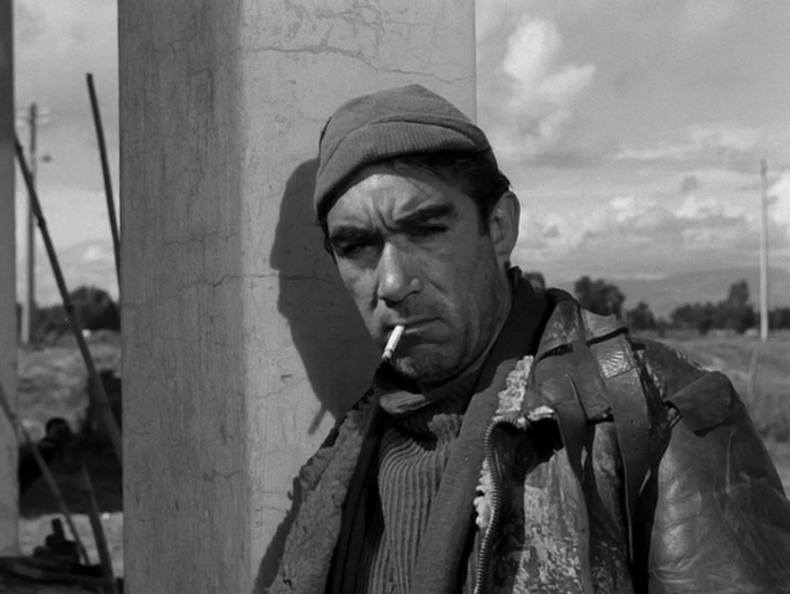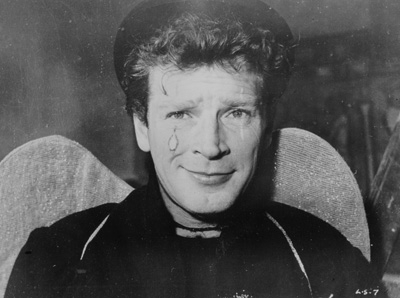La Strada And Its Message About Life

Life is a road. It’s full of surprises, happiness, and sadness. Federico Fellini’s La Strada (1954) perfectly captures this. The title of the film, in English, means “the road”. The road that the characters must journey on in this film is one that deals with internal conflicts and life’s crazy challenges. Albeit sad, this film’s beauty overshadows its tragedy as it conveys a message that is inspiring and important, especially during these trying times.
The film takes place in 1950’s Italy as the two main characters, portrayed by Giulietta Masina and Anthony Quinn travel through different cities as traveling showmen. The film’s style is rooted in Italian Neorealism but sprinkled with Fellini’s Felliniesque details.
In this post, I will talk about the film’s characters and what each of them can teach us about life. But first, a summary of the story.
La Strada tells the story of Gelsomina, an innocent and poor young woman, whose mother sells her to Zampanò, a traveling showman. Zampanò uses Gelsomina as an assistant for his show, but is cruel to her and ignores her the rest of the time. Despite Zampanò’s aggressiveness, Gelsomina is determined to stick with Zampanò. Her innocence and resilience protect her from the cruel world she lives in. At one of their stops, Zampanò joins a circus, where he and Gelsomina meet The Fool, a tightrope artist, who forms a friendship with Gelsomina and a feud with Zampanò. The Fool teaches Gelsomina to play a song on the trumpet and helps her find her purpose in life. However, the friendship is ruined when Zampanò kills The Fool in a fit of anger. Gelsomina, traumatized, becomes distant and quiet. After realizing that she will never be the same, Zampanò abandons her. Years later, working for a traveling circus, Zampanò returns to the town where he left her and hears a woman singing the song that Gelsomina always played on her trumpet. The woman tells him that she learned the song from a woman who lived there a couple years ago. She says that the woman was very quiet and cried a lot until one morning, she died. Zampanò, surprised and taken aback, walks along the beach until he collapses and begins to cry inconsolably.
Let’s start with Zampanò.

Zampanò is a very angry and closed off person. He never shows any kindness, not even to Gelsomina, who sticks with him despite his violence towards her. This is a man with demons that have turned him into a vile human being. He is the image of a person that has become so numb that he walks through the world without love or compassion. Zampanò never allows himself to feel anything as if he is too afraid to feel.
Towards the end of the film, when Gelsomina becomes ill, he begins to show a little bit of kindness to her, in his own cold way. Once he realizes what he has done, he believes he will never have peace again. He says: “I didn’t mean to kill him. I just punched him a couple of times. He was not hurt… I turn around, he drops dead. Now I must spend the rest of my life in prison for a couple of punches? I only want to work in peace. Don’t I have the right to live?”. The prison he mentions is his own mind and consciousness. He previously had told Gelsomina that there was no way they would be caught and that she should not be worrying; therefore, he isn’t talking about a physical prison, he’s talking about his mind and expressing what he will feel like for the rest of his life. This is the first time that Zampanò shows any sign of emotion. He is showing regret for his actions. He let his anger and hatred take hold of him and killed an innocent man and Gelsomina’s spirit. The realization that Gelsomina will never be the same, makes him uncomfortable and pushes him to leave. She is a constant reminder of what he is capable of and what he was capable of.
In the end, when he hears the lady singing Gelsomina’s song, he has hope that Gelsomina might still be alive. Maybe he could apologize, but Gelsomina is dead. He breaks down at the beach, where he first met her, and feels all the remorse and regret he has been carrying. As Gelsomina’s song plays in the background, the viewer sees the image of a man finally broken by guilt and regret.
In contrast to Zampanò, Gelsomina is similar to a child.

Before Zampanò, Gelsomina had never been out of her town. Everything she saw with Zampanò was new. Her glittering wide eyes filled with hope and curiosity resembled a child in an amusement park. The world was her amusement park. She didn’t yet know the cruelties that lived within it. Even though Zampanò was horrible to her, she still managed to care for him and was willing to stick by his side.
Gelsomina had multiple opportunities to escape Zampanò, but she would not do it. Once, she told The Fool that even if she left, it would be the same result because she was useless and she was sick of living. The Fool asked her what she was good at, and because she had no answer, he said that, perhaps, her purpose was to be with Zampanò and help him, since he behaved like a dog. After this, Gelsomina was convinced her purpose was to be with Zampanò and help him with his bruteness. When she saw Zampanò kill The Fool, a switch went off in her mind, heart, and soul. All the innocence and excitement she had, left her body. She became quiet, distraught, and scared of Zampanò. Then, Zampanò abandoned her and we never got to see her again. We only hear from the lady that speaks to Zampanò about her. The lady says that Gelsomina never talked, never ate, and cried a lot. Zampanò’s evil killed Gelsomina’s bright spirit. She felt her purpose, to help Zampanò, was not real. She felt worthless again.
Furthermore, Gelsomina is a representation of how this world can tear you down. Sometimes, when one is innocent and kind, the world is mean and cruel in return. It is hard to stay kind, but one must show kindness above all. Living without kindness and compassion is living like Zampanò, full of anger and regret.
I believe Gelsomina did have a purpose. She was meant to show a cruel heartless man, the kindness and joy in the world. She was meant to teach him a lesson, which unfortunately, he learned a little too late.
Similar to Gelsomina, The Fool is a bright spirit. He is, perhaps, the most important character to me.

I think it’s ironic that he was named The Fool. To society he might have seemed like a fool, but in my opinion, he was living the smartest and most relaxed life he could. If society learned from this fool, it would be much more relaxed and kinder. The Fool has seen how cruel this world can be and decided to make life a joke. He didn’t take anything too seriously. Even when Zampanò chased him around with a knife, he made jokes. He had no attachments to people or objects. He didn’t know where he was going, and he was content with that. He is calm because he knows he has a purpose, and he shows Gelsomina how to find hers as well.
“I am ignorant, but I’ve read some books. You may not believe it but everything in this world has a purpose. Even this pebble. Even this has a purpose” he said as he held a pebble in his hand. “And what is its purpose?” Gelsomina asked. To which he replied: “If I knew I’d be the Almighty who knows everything… I do not know what this pebble’s purpose is, but it must have one because if this pebble has no purpose, then everything is pointless. Even the stars. At least, I think so. And you too. You have a purpose too”. This scene is superb, and it perfectly conveys a sort of answer to the million-dollar question that every human being has asked themselves: Why are we here?
There is no exact answer to this question. We can only live our lives and accept that everything in this world has a purpose, even the pebbles and the stars.
Ultimately, La Strada is one of my favorite films because of what it means to me. Of course, it has many interpretations and this is just my own, but the acting, the story and its message, whichever you find, are undeniably marvelous and can teach us a thing or two about life. It shows that life is not perfect. It’s sad and filled with struggles. One day we have everything, the next day, we don’t. What the road holds is unknown but there is beauty in this unknown.


